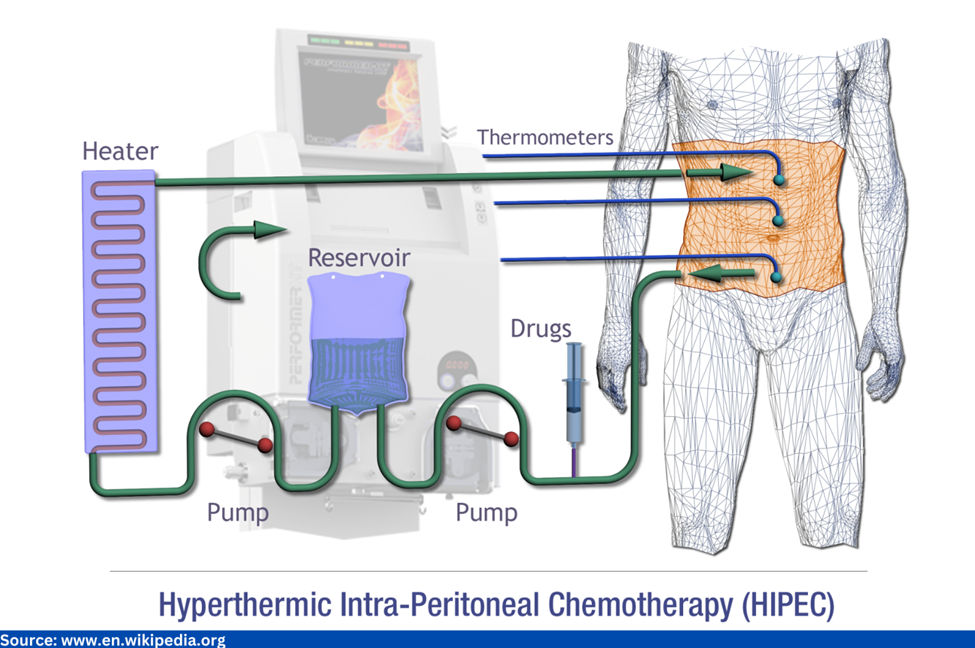Cytoreductive surgery with hyperthermic intraperitoneal chemotherapy (CRS-HIPEC) is a type of supra-major surgery to treat certain cancers of the appendix, colon, mesothelioma, ovary, pseudomyxoma peritonei, and rectum. These cancers can progress within the abdominal cavity, resulting in peritoneal metastases, wherein deposits of tumors develop in the inner layer of your abdomen (peritoneum), as well as on other organs and tissues.
Hyperthermic intraperitoneal chemotherapy (HIPEC) is a specialized treatment used to treat certain types of cancer that have spread to the abdomen (peritoneum). Cytoreductive surgery (CRS) is an integral part of the HIPEC procedure. CRS is the surgical removal of as much cancerous tissue as possible from the abdominal cavity. CRS is followed by the delivery of chemotherapy directly to the abdominal cavity through a heated perfusion solution.
Renowned surgical oncologist in India, Dr. Sandeep Nayak, explains, “The goal of CRS is to reduce the size and number of cancerous tumors in the abdominal cavity as much as possible. This helps to increase the effectiveness of the chemotherapy solution, as it can reach and target more cancer cells.”
Dr. Sandeep Nayak is among the preferred cancer surgeons for people seeking HIPEC treatment in Bangalore.
Procedure of Cytoreductive surgery with HIPEC
Cytoreductive surgery and HIPEC procedures are typically performed by a team of highly experienced surgeons, anesthesiologists, and other medical professionals in an operating room. It usually takes several hours to complete and is typically performed as part of an extensive procedure to remove cancerous tissue.

Here is an overview of the steps involved in Cytoreductive surgery and hyperthermic intraperitoneal chemotherapy treatment:
- Anesthesia: The patient is given general anesthesia to put them to sleep and prevent any pain during the surgery.
- Cytoreductive surgery: CRS is the process that involves the surgical removal of cancerous tissue. The surgeon will make an incision in the abdomen and remove as much cancerous tissue as possible. This may include the removal of organs or other tissue, depending on the location and extent of the cancer.
- Insertion of a heated perfusion system: A heated perfusion system is inserted into the abdominal cavity through a small incision. This system circulates a heated chemotherapy solution throughout the abdominal cavity.
- Administration of chemotherapy: The chemotherapy solution is perfused through the abdominal cavity for a specific period, usually around 90 minutes. The heat helps to increase the effectiveness of the chemotherapy.
- Closure of the incision: Once the chemotherapy has been administered, the incision is closed, and the patient is taken to the recovery room to awaken from the anesthesia.
HIPEC is a complex and highly specialized procedure and is not available at all cancer centers.
Dr. Sandeep Nayak says, “HIPEC is typically reserved for patients with advanced-stage cancer that has spread to the peritoneum. It is usually used in combination with other cancer treatments, such as chemotherapy or radiation therapy.”
When Is CRS-HIPEC Used?
Cancer specialist Dr. Sandeep Nayak may employ HIPEC and Cytoreductive surgery to treat advanced-stage cancer that has spread to the peritoneum, a thin layer of tissue that lines the abdominal cavity and surrounds the abdominal organs. This type of cancer is known as peritoneal carcinomatosis.
- Peritoneal carcinomatosis can occur in various types of cancer, such as:
- Appendiceal cancer: Cancer that arises when the cells that make up your appendix divide and multiply uncontrollably.
- Colorectal cancer: Cancer that develops in the cells between your colon (large intestine) and rectum (anus).
- Gastric or stomach cancer: A relatively rare type of cancer that develops in the stomach lining.
- Mesothelioma: A rare and aggressive cancer that develops in the lining of the abdomen (peritoneal), lungs (pleural), or heart (pericardial). It is caused due to exposure to asbestos, a fibrous mineral once widely used in building materials, insulation, and other products.
- Ovarian cancer: Cancer that occurs in the ovaries.
- Psuedo-myxoma peritonei: Cancer that occurs in the cells lining the inside of your belly and produces jelly-like material.
According to oncology expert Dr. Sandeep Nayak, “Complex judgments must be made when treating peritoneal disease patients. We believe that in order to help patients get the best results, every one of these individuals should be screened at a specialized facility with a highly-skilled and focused team.”
Cytoreductive surgery with HIPEC – Success rate
- The median overall survival for patients with colorectal peritoneal metastases receiving chemotherapy alone ranges between 8 – 15 months, but for those receiving CRS-HIPEC, the median survival is between 22 – 47 months, with a 5-year survival rate of 27% to 54%.
- CRS-HIPEC has significantly increased 5-year survival in patients treated for appendix peritoneal metastases and mesothelioma from less than 10% – 50% to 90% and is now the norm for these types of tumors.
- Studies conducted on 1051 patients treated for ovarian cancer with CRS-HIPEC indicated a median survival of 73 months.
- Additionally, a couple of phase 3 randomized clinical trials examining CRS-HIPEC in recurring and primary grade III ovarian cancer showed that HIPEC produced a 2-fold overall survival rate and overall survival benefit of 11 months, respectively.
Recovery
An Oncologist in India, Dr. Sandeep Nayak says, “The ability to recover following CRS-HIPEC treatment relies on the severity of your cancer and the scope of the procedure. The length of surgery might range from 5-12 hours, with a subsequent 10- to 14-day hospital stay. Usually, recovery takes 2-3 months.”
You may experience the following side effects during your recovery period:
- Bloating
- Problems with bowel movements – constipation/diarrhea
- Trouble sleeping
- Weight loss
- Nausea
- Tiredness
Conclusion
An Oncologist in India, Dr. Sandeep Nayak says, “The ability to recover following CRS-HIPEC treatment relies on the severity of your cancer and the scope of the procedure. The length of surgery might range from 5-12 hours, with a subsequent 10- to 14-day hospital stay. Usually, recovery takes 2-3 months.”
You may experience the following side effects during your recovery period:
- Bloating
- Problems with bowel movements – constipation/diarrhea
- Trouble sleeping
- Weight loss
- Nausea
- Tiredness
FAQ
What is removed in Cytoreductive surgery?
CRS involves the removal of visible malignant tumors from the abdominal cavity. The next step is HIPEC, where the cavity is drenched in hot chemotherapy heated to 42 °C to eliminate any tiny cancer cells that may still be present.
How is HIPEC different from traditional chemotherapy?
Traditional chemotherapy is administered intravenously to target cancer cells. Unfortunately, peritoneal carcinomatosis frequently has a low or restricted blood supply, making it more challenging for intravenous chemotherapy to destroy these tumors.
Thanks to HIPEC, chemotherapy medications are able to interact directly with microscopic cells that remain in the peritoneal cavity.


